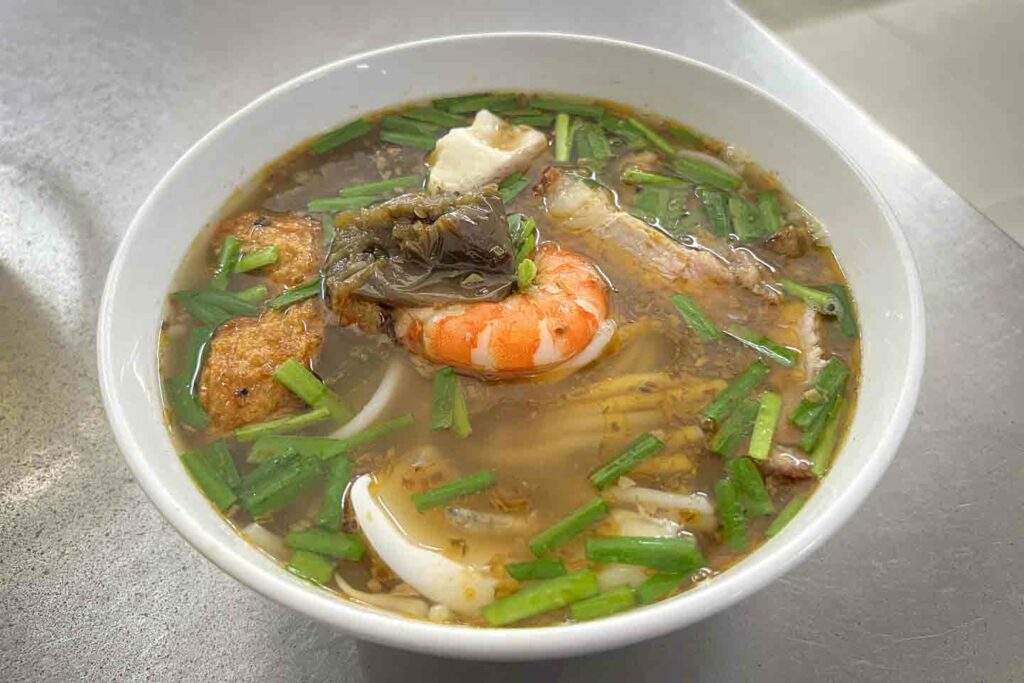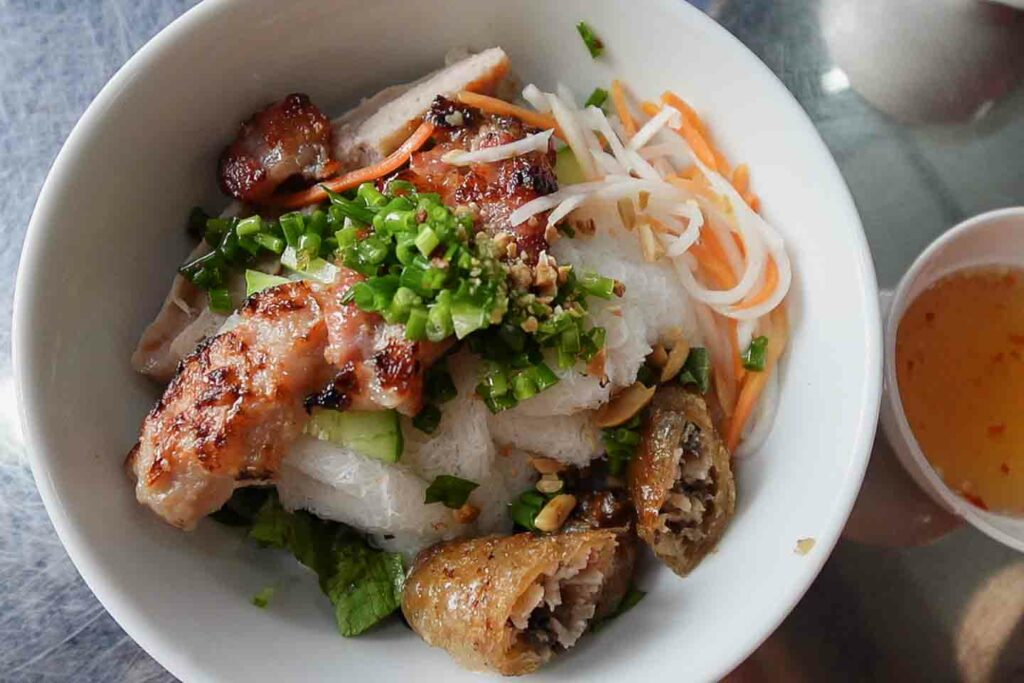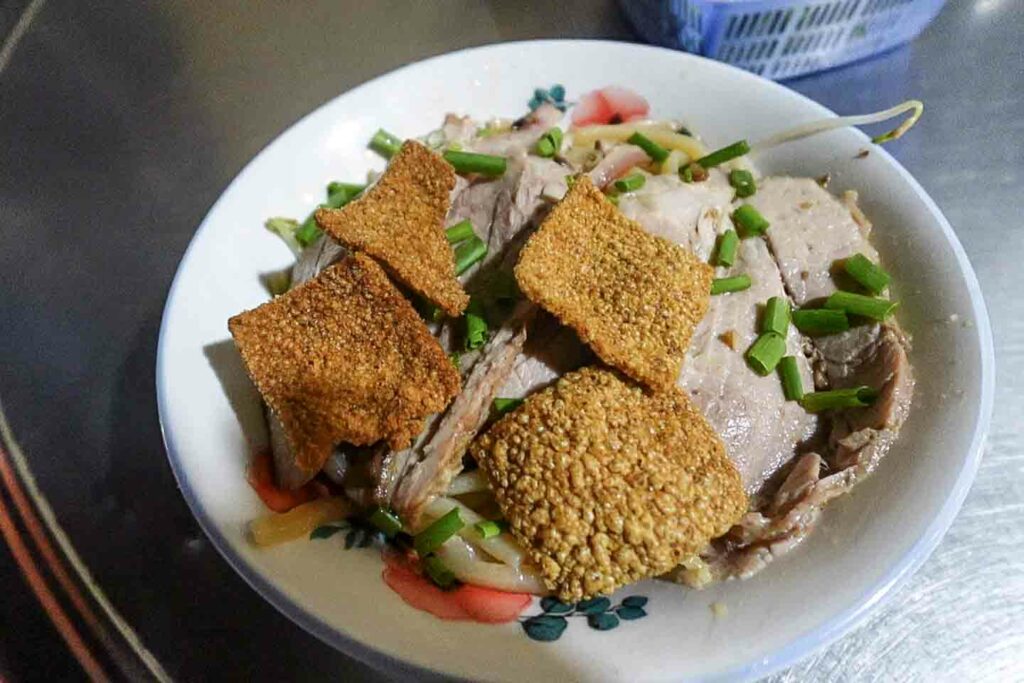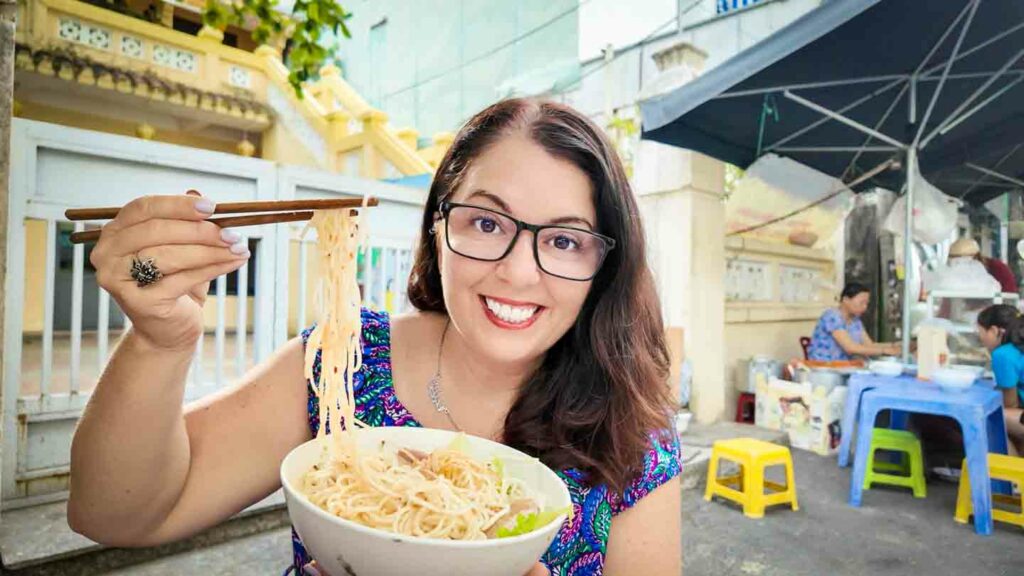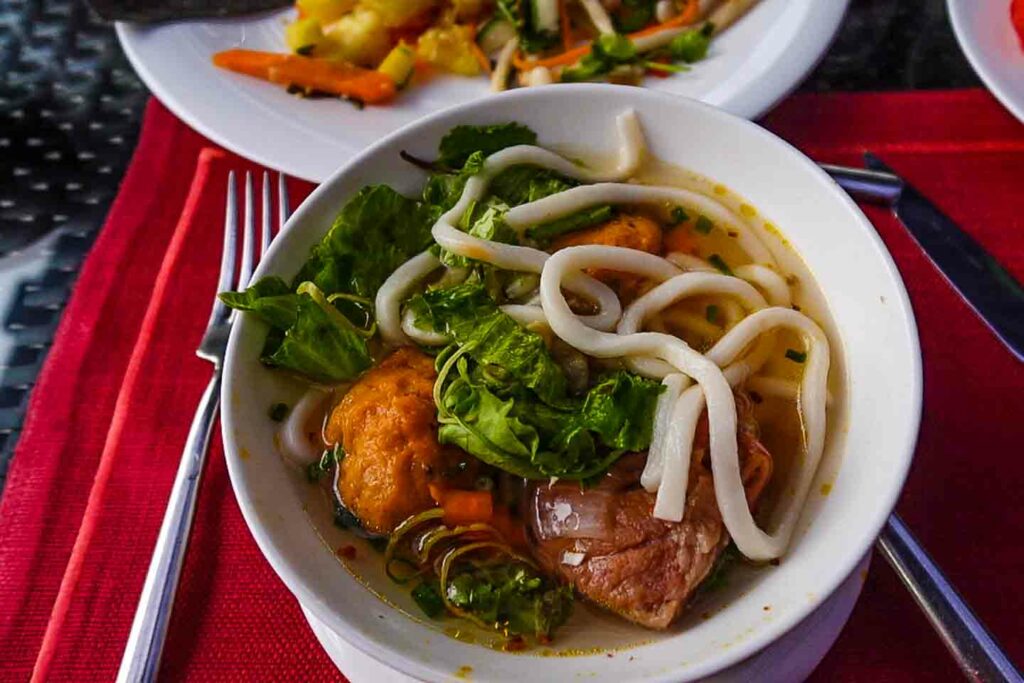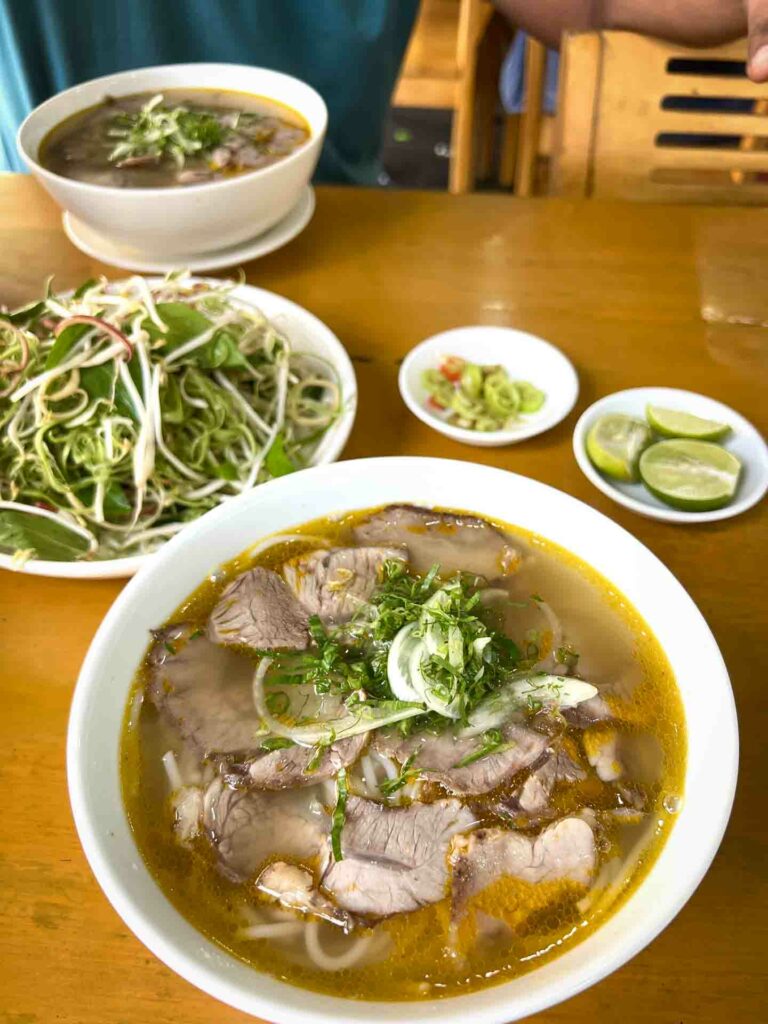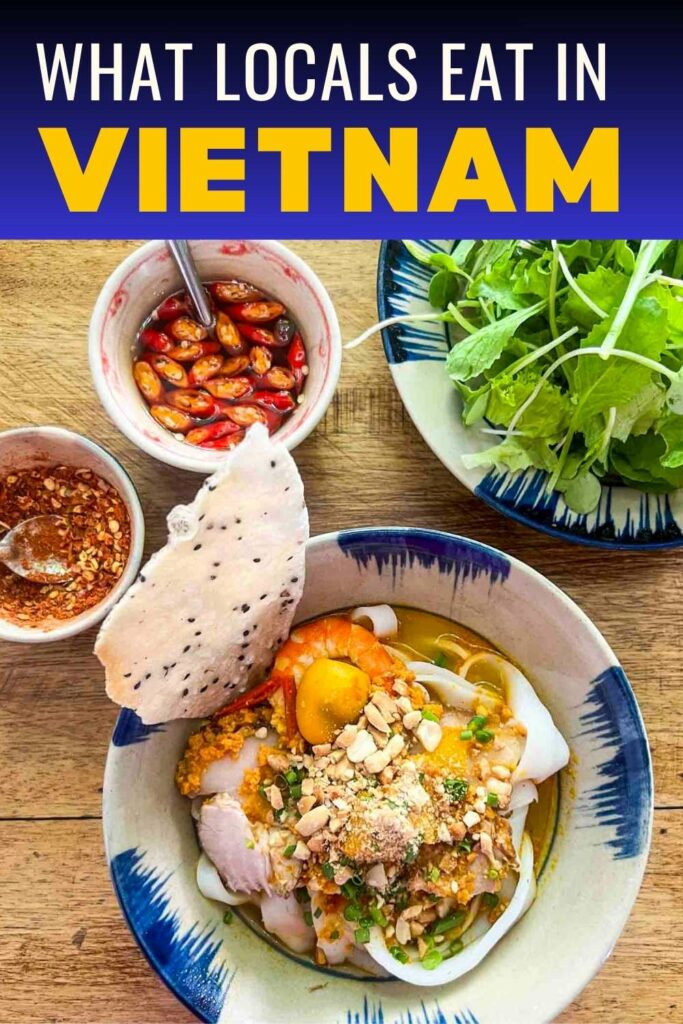Everyone knows pho. It’s the Vietnamese dish that made it big around the world. But here’s the thing about the Vietnamese noodles scene – pho is just the beginning.
I’ve been to Vietnam 5 times, often staying as long as my visa would allow and I have something controversial to share:
Pho is my least favorite noodle.
There’s nothing wrong with it. I still eat it often. It’s fantastic for breakfast. I love how it changes from city to city. Pho is Hanoi is much different than Ho Chi Minh City.
But I usually only order it when there are no other noodles available on the menu.
From fermented fish broths that smell like parmesan to noodles that can only be made in one city, Vietnamese noodle culture runs deep. Each region has its own specialties, cooking methods and flavor combinations that most travelers never discover.
This isn’t meant to shame your love for pho, but to inspire you to seek out better noodles.
My Favourite Vietnamese Noodles
These ten dishes changed how I think about Vietnamese food. They represent centuries of culinary evolution, regional pride and family recipes passed down through generations.
Some pack intense umami punches while others surprise with their delicate flavors.
.Bún Mắm – The Fermented Fish Broth That Smells Like Parmesan
Bún mắm hits you before you even taste it. The smell is intense, almost cheese-like, which tells you this broth is packed with umami.
This fermented fish broth originated in the Mekong Delta where freshwater fish are common.
The base comes from mắm cá, a fermented fish paste that’s been aging for months. Cooks combine this with fresh fish, shrimp, squid and sometimes crab to create a broth that’s rich but never overwhelming.
The dish reflects the Mekong’s geography perfectly. River communities developed fermentation techniques to preserve fish during flood seasons. What started as necessity became a cornerstone of southern Vietnamese cooking.
Tropical Fruits in Vietnam
When you eat bún mắm, you’re getting rice vermicelli noodles in this complex broth. The seafood varies by season and what’s fresh at the market. Some versions include morning glory stems, bean sprouts and herbs for texture contrast.
The first sip is always a surprise. Despite the strong aroma, the taste is balanced – salty, savory and deeply satisfying. It’s like drinking liquid umami with none of the fishiness you might expect.
Where to Eat Bun Mam
Bún Mắm Abc
13 Đ. Ngô Tất Tố, Phường 19, Bình Thạnh, Hồ Chí Minh, Vietnam
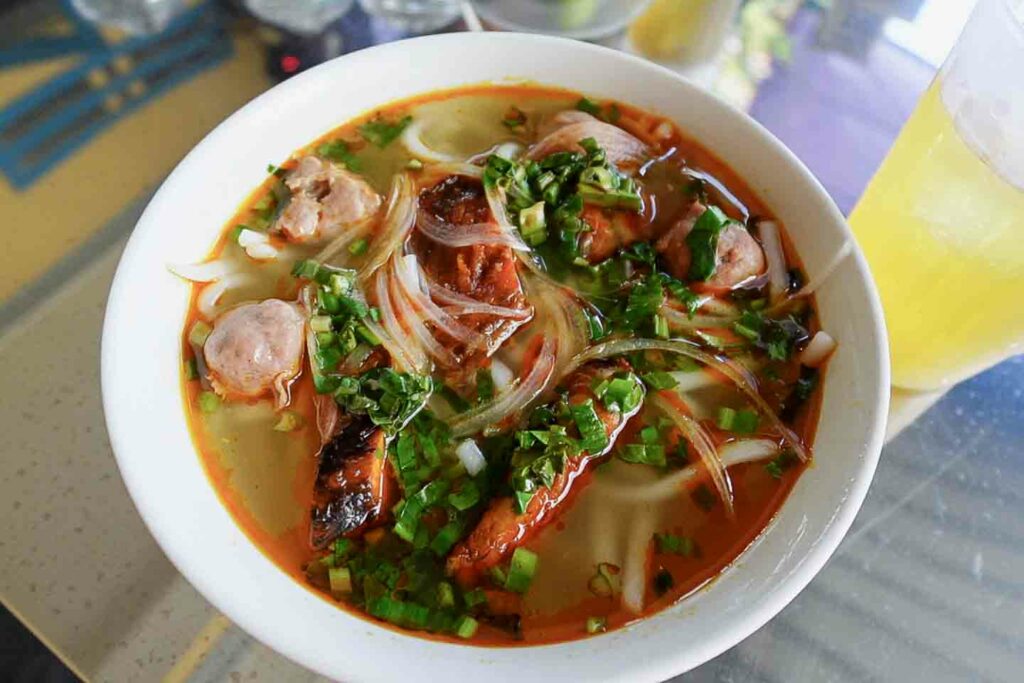
Bánh Canh Hoi An – The Noodle Dish That Tastes Like Smoke
Hoi An’s version of bánh canh proves that the same dish can taste completely different depending on where you eat it. While southern Vietnam serves bánh canh as a thick, hearty soup, Hoi An leans toward a lighter, cleaner broth that highlights fresh herbs and seafood.
The key difference is the fish. Hoi An cooks traditionally use snake fish, which has a naturally smoky flavor. When snake fish isn’t available, they substitute with local river fish that give similar results. The smoking effect comes from the fish itself, not the cooking method.
Hoi An
These thick rice noodles have a chewy texture that’s almost like udon. They’re made from rice flour and tapioca starch, which creates that distinctive bite. The noodles hold up well in the light broth without getting mushy.
Hoi An’s location on the Thu Bon River means fresh fish is always available. The clear broth lets the fish flavor shine without heavy spices or aromatics masking it. Just fish, noodles, some pork balls and fresh herbs.
The cooking technique is simple but precise. The broth simmers gently to extract maximum flavor without making it cloudy. Fresh lime juice brightens everything up at the end.
Where to eat Banh Canh
Bánh Canh Ruộng
464/9 Cửa Đại, Cẩm Châu, Hội An, Quảng Nam, Vietnam
Bún Thịt Nướng – The Mekong’s Answer to Grilled Pork
This southern specialty showcases the Mekong Delta’s love for contrasting textures and flavors. Rice noodles as soft as clouds form the base, topped with grilled pork belly, Vietnamese sausage and a crispy fried spring roll.
The dish tells the story of southern Vietnam’s agricultural abundance. Rice paddies provide the noodles, pig farms supply the meat and local vegetables fill out the plate.
It’s comfort food that reflects the region’s prosperity.
Vietnamese sausage in the south differs from northern versions. Southern cooks mix pork with fish sauce, sugar and sometimes coconut milk. The result is sweeter and more complex than simple pork sausage. The fat content stays high without being greasy.
The fried spring roll adds crucial crunch. Inside you’ll find taro, mushrooms, bean sprouts and mung beans mixed with pork. It’s wrapped in rice paper and fried until golden.
Where to Eat Bun Thit Nuong
Bún Thịt Nướng Hằng
27 Yersin, Cau Ong Lanh Ward , District 1 , HCMC, Vietnam
Bún Chả – Hanoi’s Sweet and Smoky Masterpiece
Bún chả represents everything great about northern Vietnamese cooking. It’s sweet, salty, smoky and perfectly balanced.
This is the dish that made Hanoi famous among food lovers.
The magic happens over charcoal. Pork belly and ground pork patties grill over hot coals, developing that characteristic smoky flavor. The fat drips down, creating flare-ups that add even more complexity.
Northern Vietnamese food tends to be less sweet than southern dishes, but bún chả is the exception. The dipping broth combines fish sauce, rice vinegar, sugar and water. The sweetness comes from palm sugar, creating a caramelized depth that Westerners love.
Hanoi Street Food
The dish reflects Hanoi’s role as Vietnam’s cultural center. Bún chả became popular with government workers and students who needed quick, satisfying meals. Street vendors set up in the Old Quarter, grilling pork over small charcoal braziers.
You eat bún chả by combining elements in your bowl. Rice noodles go in first, then broth, then meat. Fresh herbs and vegetables add brightness and crunch. The key is getting the right ratio of each component.
The Old Quarter remains the best place to eat authentic bún chả. Despite heavy tourism, local workers still crowd these tiny restaurants during lunch hours. The economic hub attracts locals who demand quality food at reasonable prices.
Where to Eat Bun Cha
Bun Cha Huong Lien
24 P. Lê Văn Hưu, Phan Chu Trinh, Hai Bà Trưng, Hà Nội, Vietnam
Bún Cá Sữa – Nha Trang’s Jellyfish Surprise
Nha Trang’s coastal location shapes its noodle culture in unique ways. Bún cá sữa combines fresh fish with jellyfish, creating textures you won’t find anywhere else in Vietnam.
Jellyfish might sound intimidating, but it’s actually quite mild.
The texture is the main attraction. It is chewy, almost crunchy, with very little flavor. Think of it as the ocean’s version of rice noodles. Nha Trang fishermen have been eating jellyfish for generations.
The fish broth stays light and clear, letting the seafood flavors shine. Local fish varieties change seasonally, so each bowl tastes slightly different depending on what’s fresh. The broth gets a squeeze of lime juice and sometimes a touch of fish paste for depth.
Phu Quoc Night Market
Nha Trang’s Chinese influence shows up in the jellyfish preparation. Chinese traders brought jellyfish processing techniques to Vietnamese coastal cities centuries ago. The preparation involves salt-curing the jellyfish, then soaking it in fresh water to remove excess salt.
Where to Eat Bun Ca Sua
Quán 24 Bà Triệu
24 Bà Triệu, Phương Sài, Nha Trang, Khánh Hòa 650000, Vietnam
Cao Lầu – The Noodle That Exists Nowhere Else
Cao lầu is Hoi An’s most famous dish, and for good reason. These noodles literally cannot be made anywhere else in the world. The secret lies in Hoi An’s unique water source and traditional preparation methods.
The noodles require water from the Ba Le well, located in Hoi An’s ancient quarter. This water has a specific mineral content that affects how the rice flour behaves during noodle making. Without this water, the noodles don’t develop their characteristic chewy texture.
The second secret ingredient is ash from local cây lọc trees. Cooks burn the bark, collect the ash, then soak rice in ash water before making noodles. This alkaline treatment changes the rice’s protein structure, creating noodles that are chewier than typical Vietnamese rice noodles.
The process connects directly to Hoi An’s history as a trading port. Chinese merchants brought alkaline noodle-making techniques to Hoi An centuries ago. Local cooks adapted these methods using available ingredients, creating something entirely new.
The pork in cao lầu is special too. Hoi An’s pork has a reputation throughout Vietnam for being exceptionally tender and flavorful.
The dish typically includes rice crackers, bean sprouts and herbs.
Where to Eat Cau Lao
Quán Cơm gà CÔ DIÊN
625 Hai Bà Trưng
Mi Quang – Central Vietnam’s Turmeric Treasure
Hands down my favourite noodle in Vietnam. Mi Quang represents central Vietnamese cooking at its best. When I’m in Hoi An I can’t go more than 2 days without eating it at my favourite restaurant (below).
This flat rice noodle dish from Quang Nam province combines complex flavors with minimal broth, letting each ingredient shine.
The defining characteristic is the turmeric-colored broth. Fresh turmeric root gives the broth its golden color and earthy flavor. Central Vietnamese cooks prefer fresh turmeric over dried powder, creating a more vibrant taste and deeper color.
The noodles themselves are wider and flatter than typical Vietnamese rice noodles. They’re made specifically for mi quang, with a texture that holds up well with minimal broth. The flat shape helps capture and hold the flavorful liquid.
Getting Robbed in Vietnam
Toppings vary but usually include shrimp, pork and quail eggs. The combination reflects central Vietnam’s access to both sea and land proteins. Quail eggs are considered a delicacy and add richness to the dish.
But where I go they also have an amazing fish mi quang, really tasty beef mi quang and also a vegetarian option.
Once I visited and they asked if I wanted to try the daily special with chicken. I hesitantly said yes as chicken is my least favorite protein but it was also amazing.
Where to Eat Mi Quang
Mi Quang 92
112A Đ. Trần Cao Vân, Phường Minh An, Hội An, Quảng Nam, Vietnam
Bún Mắm Nêm – Da Nang’s Fermented Wake-Up Call
Da Nang’s version of bún mắm is completely different from the Mekong Delta version. Instead of a brothy soup, this is a dressed noodle dish that packs intense flavors designed to wake you up.
The star ingredient is mắm nêm, a fermented anchovy paste that’s funkier and more intense than regular fish sauce.
This paste ferments for months, developing complex flavors that are salty, umami-rich and slightly sour. It’s mixed with garlic, chili and pineapple to create a sauce that’s both fiery and sweet.
Pineapple might seem like an odd addition, but it’s typical of central Vietnamese cooking. Instead of using refined sugar, central Vietnamese cooks prefer natural sweeteners like pineapple, coconut or palm sugar. The pineapple’s acidity also helps balance the intense saltiness of the fermented paste.
The dish includes sliced pork belly and crispy pork skin for richness and texture. Da Nang style beef sausage adds another element. The sausage is seasoned differently than northern or southern versions, with more garlic and black pepper.
Rice noodles provide the base, but they’re just a vehicle for the intense flavors. Fresh herbs and vegetables help cool down the heat and add freshness. The key is mixing everything together to distribute the sauce evenly.
This dish is traditionally eaten as a morning meal. The intense flavors and spice level work like a natural alarm clock, energizing you for the day ahead.
You can find it easily in the market but there are many tourists there. If you walk around the neigbourhood you can eat it with locals.
.Bánh Canh Central Style – The Thick Noodle Comfort Food
Central Vietnam’s bánh canh differs significantly from both northern and southern versions. The noodles are made from rice flour and tapioca starch, creating a chewy texture that’s almost like thick udon.
The broth stays light but flavorful, usually made from pork bones that simmer for hours. Pork hock adds richness and gelatin, creating a broth that coats your mouth without being heavy. Fish cake adds a different texture element.
The noodles themselves are the star. They’re hand cut and irregular, which means each bite is slightly different. The tapioca starch gives them a bouncy texture that’s satisfying to chew. They don’t break apart easily, even in hot broth.
Vietnamese New Year
This dish represents central Vietnamese cooking philosophy to use fewer ingredients prepared perfectly rather than complex flavor combinations. The focus is on technique and quality ingredients rather than elaborate seasonings.
Regional variations exist throughout central Vietnam. Some areas add different vegetables or proteins based on local availability.
The basic concept remains the same – thick noodles in flavorful broth with simple, quality ingredients.
Bún Bò – Hue’s Royal Noodle Legacy
Bún bò originated in Hue, the former imperial capital of Vietnam. This beef noodle soup reflects the royal court’s influence on Vietnamese cuisine, with complex flavors and elegant presentation.
The broth is the foundation. Beef bones simmer for hours with lemongrass, creating a clear but intensely flavored base.
Lemongrass gives the broth its distinctive aroma and citrusy undertones. The cooking process requires patience and attention to detail.
The noodles are thick, chewy and round, similar to udon but made from rice flour.
Vietnam’s Best Beaches
Hue’s location in central Vietnam means the dish isn’t as sweet as southern versions or as simple as northern ones.
It strikes a balance between regions, with complex flavors that don’t overwhelm. The royal court’s influence shows in the refined taste and presentation.
Bean sprouts add crucial crunch and freshness. They’re usually blanched briefly to remove the raw taste while maintaining texture. Fresh herbs like cilantro, mint and Thai basil provide aromatic contrast to the rich broth.
The dish spread throughout Vietnam as people migrated from Hue to other cities. Each region adapted it slightly, but the original Hue version remains the most refined and complex.
.Why These Dishes Beat Pho
People love pho for a very good reason. It’s approachable, with familiar flavors and ingredients that don’t intimidate newcomers. The clear broth and simple presentation make it comfort food for people worldwide.
But these ten dishes represent Vietnam’s true noodle diversity and share the story of each region.
The next time you’re in Vietnam, skip the pho restaurants in tourist areas. Instead, look for local noodle shops where Vietnamese families eat.
Follow the crowds, try dishes you can’t pronounce and discover why Vietnamese noodle culture is so much more than just pho.
Everyone uses Google Translate in Vietnam so if you have any allergies or food restrictions whip our your phone. Vendors are more than happy to help!
